Alaska Fish & Wildlife News
December 2018
Yukon River Moose Meet
An Alaska Winter Hunting Adventure
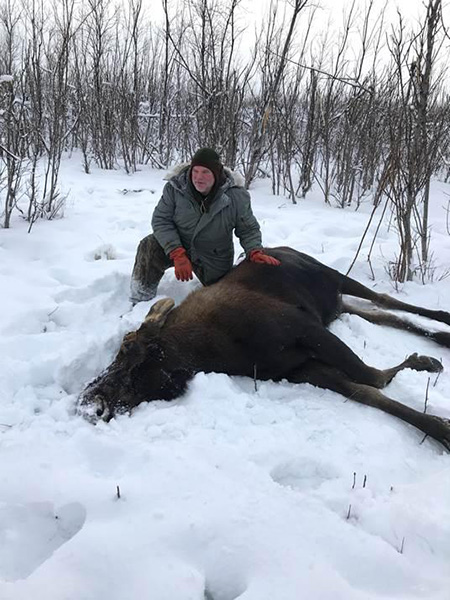
I got the heads-up call the second week of February from Doug in Bethel. The next week was forecast for colder weather and snow. The plan was to go hunting for moose or muskox on sno-gos (the local term for snow machines). I started packing.
Doug called the following Wednesday and said they planned to go hunting for muskox on Friday. He had a tag, and I could have lots of meat since his freezer was full. I threw my gear together, bought a one way mileage ticket from Juneau to Bethel, and was in Bethel about noon the next day. Mileage tickets are an Alaskan hunter’s best friend for short notice travel in the state.
When I got to Bethel, I realized I forgot my fur hat and snowmobile pants, but otherwise looked good for proper clothing. Doug lent me a beaver hat and I planned to use rain pants in lieu of snowmobile pants if it rained.
We had a dinner of crock pot moose roasts, potatoes, canned green beans and salad. Val, my college classmate from Sand Point and Doug’s wife, made brownies for us to take on the trip. And to have with ice cream for dessert.
Later in the evening, word came of a change of plans. The weather had deteriorated on the coast. Instead of heading to the Bering Sea for muskox, we were heading to the Yukon River for moose. Many years ago I’d sewn up a bunch of XXL game bags from used sheets, and now they might get some use.
The Hunt is On
Doug and I were both up the next morning by 4:30 am, excited to go, packing and checking gear and drinking coffee. When we met the rest of the hunting party - Pat, Chris, Sam and Robert- I could tell they were excited too. It’s not every day you take a trip 75 miles to the Yukon River by sno-go to hunt moose, even if you live here. We left town in the dark at 8:15 am. Everyone except me had a 10’ heavy duty plastic sled in tow behind their sno-go. In the sleds were tents, sleeping bags, camping gear, extra fuel and food. We were prepared.
We traveled all morning in the fog north to the Yukon River. Across tundra and lakes and creeks. Although we couldn’t see the surroundings, the fresh snow the night before made for good riding, and all the tracks we came across - wolf, fox, lynx, wolverine, rabbit and moose - were fresh.
We’d stop every five or 10 miles. The others all tightened the straps holding their loads to their sleds, and we checked each other’s face for frostbite. It wasn’t very cold - about 20 degrees - but you make your own wind chill on the sno-go.
I was last in line when I saw a red fox doing its morning thing out on the tundra. I’d heard the fox were big in these parts, and the sighting confirmed that.
We got to a river near the Yukon about 11 am. There were fresh moose tracks leading to an isolated stand of willows. Chris and Robert turned back and followed the tracks around the stand of trees. Chris saw two moose and got both of them. We all drove up to the downed moose, and we were soon like a NASCAR pit crew. Pat and Sam led by making the first cuts in the moose. Pat instructed the rest of us on what needed to be done after that, and soon we all had our roles for future sessions the rest of the day. By 11:45 am, we had both moose butchered. We didn’t worry about getting the meat dirty. I could just hang onto a piece while it was cut away and toss it in the fresh snow until it was time to put it on the sled. No flies to worry about in February. Or bears. I could get used to this.
The hide from the moose went fur side down in the sled. Then the moose parts - neck, sternum, ribs, pelvis, hind quarters, and front quarters - went on top of the hides. The forelegs and head also went in for trapping bait. The moose parts were covered with a tarp and secured to the sled with ropes and ratchet straps.
The only thing left when we departed were the entrails. In a day or two, all that would be left would be the willow material inside the stomach after the ravens, crows, foxes and other critters ate their fill. What a day already.
We traveled about an hour longer, traversed the divide from the Kuskokwim River drainage into the Yukon River drainage, and made camp in a stand of small spruce trees where the group had camped before. We passed two others on sno-gos on their way back to town, each with a sled full of moose. They would be the only people we’d see today.
As we set up camp, Chris offloaded his moose parts onto the snow. Even in the cold, the meat holds a lot of heat and can start to spoil if piled together too long. We set up the tents and camping gear at a leisurely pace. Then we were off to the Yukon River- another 10 miles or so.
We arrived at the river and crossed to an island covered with willows. Normally, willows have a sort of half-moon shape when you view them from a distance, with the middle stems of the tree reaching up 30 feet or more. This stand, though, looked like a fine trimmed lawn about seven feet high. Willows trimmed to this level is a sign of lots of moose – so many so that this area is one of the only areas in the state that allows a two moose bag limit for Alaska residents during part of the year.
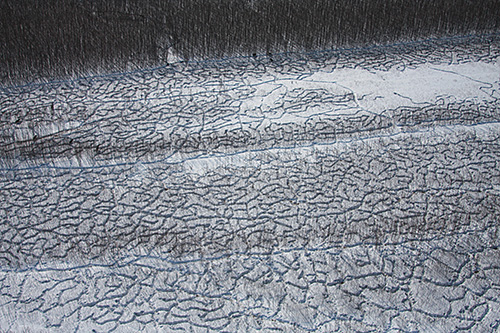
Soon after arriving on the island, some in the front were motioning to me that moose were ahead. I soon saw moose heads moving above the willows. There were six or eight moose moving. Pat motioned me to come forward for a shot. When I caught up to him, all I could see were legs in the willows. Lots of legs. It was like looking at a herd of wild horses in the brush. I kept walking forward and there lay a moose on the ground. Robert had shot it, yet I never heard him shoot. For some reason, the .30 caliber rifles we were shooting seemed to make little sound out on the wide open tundra, unlike the boom they make when hunting in the mountains of Southeast Alaska.
I moved past Robert’s moose. Others were anxious for me to get a moose, but I wasn’t in a hurry. I wanted to have a clear broadside shot with a good rest and not too far a shot. Then I saw it - a moose offering me a clear shot broadside at under a hundred yards. I got a rest, put the crosshairs a third of the way up from the bottom of his sternum and behind the front shoulder (as recommended on the ADF&G site) and fired. The moose just stood there. I fired a second time, and still nothing. Pat said to fire again. Then I saw the moose waver a bit and it just tipped over. It never flinched or gave any sign of being hit.
Pat moved on to stalk another moose that was initially alongside this one. A few more shots fired not far away, and we now had three moose on the ground.
Doug and Pat and I started butchering my moose, while Robert, Chris and Sam worked on Robert’s moose. After we were a good way along in the process, Pat and Doug told me to go look for a second moose. I did. I made a loop around a section of the island and back to them. They said to keep looking.
Sam and Robert had finished up Robert’s moose and came by, so I went with them for a ways, when we decided to split up. Sam and Robert crossed the river to another island, while I “kept turning left” as Sam instructed until I would return to Doug and Pat. I ventured left into a patch of willows and got the sled stuck. I was spinning out in deeper snow. I tried to lift the back of the sled up and out of the hole I’d made like I used to back in Bolivar as a kid. Turns out sleds are bigger now. And I’m not a kid. I strained my back trying to get it out. I tried whistling and yelling to Pat and Doug, but got no reply. I finally shot three times to alert them I needed help, then started walking back to find them.
Doug soon came on his sled and we returned to my sled. He showed me how to get it out by leaning the sled on its side and shoveling snow under it with your boot. I thought to myself I’m not going off on my own again like that since I’m not familiar with getting myself out of these situations and could easily get lost or separated from the group.
We got Pat’s moose and my moose butchered and down on the river as the sun was setting. I had to pinch myself standing on the frozen Yukon River in the middle of winter watching the sunset with my first moose in a sled.
Pat and Chris went to look for Sam and Robert, who we figured got another moose when they crossed to the other island, although we never heard any shots. Doug and I stayed with the sleds. Chris soon returned and said Pat sent him back to get me because there were six moose just down the way.
When I got there, I saw three moose standing in a line broadside to us, and three others moved off into the brush out of sight. The biggest moose was on the right, with what looked like a yearling in the middle and a calf on the left. I asked Pat which one I should shoot. He said the little one, which I did. Pat now decided he’d take a second moose, too, and so shot the yearling. The big one walked off. When we got up to our moose, it turns out they were not a yearling and calf at all, but adult moose. The bigger one that walked off was really big and just made them look small.
The four of us rolled my moose onto the sled and Chris ran it up to the other sleds we’d left with butchered moose. He returned and we did the same for Pat’s moose. It took a bare minimum of three of us to roll a whole moose at all, and even then it was iffy.
As we were offloading Pat’s moose to start butchering, here comes Sam and Robert. Sam HAD got a moose, which he and Robert had butchered and had on their sled. They joined in and the six of us soon had the last two moose butchered by headlamp and onto the sleds. It was now about 9:30 pm and we’d shot and butchered eight moose in the 14 hours since we left Bethel. The first moose of the day was a cow, and the rest were bulls. Of course, all bulls had dropped their antlers so we didn’t know what sex we’d shot until after the fact, but that’s the way it worked out. It looked like the bulls were in bachelor groups and I’m not sure why there seemed to be no cows here. Maybe just chance.
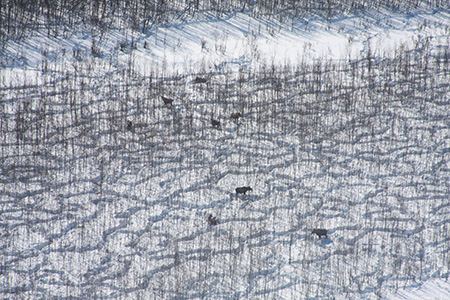
We were bushed but very satisfied on the journey back to camp. Everybody got the moose they came for. Doug didn’t get one, which was what he wanted. Doug lit his lantern and hung it on a tree, and the rest of us had our headlamps on as we took the tarps off all the sleds, and pulled the moose parts out of the sled and into the snow to cool overnight, just like Chris had done. We ate snacks and sandwiches for dinner.
Doug had borrowed a tent from a friend but we didn’t check it before we left and the little woodstove that went with the tent did not come with it. Doug, Pat and I had no stove and so slept in our sleeping bags in our hunting clothes. Doug brought in the lantern to heat up the tent before we went to sleep, then turned it out. Doug was the subject of extensive ridicule and verbal abuse the rest of the night by Pat and I, but we all seemed to sleep just fine in about 15 degree weather. I got up once to take a leak, and when I got back in my bag, I could hear a critter bothering Chris’s moose meat, which was laying in the snow next to our tent. Pat went out to look and saw it was a red fox. Pat shooed it away, but as soon as Pat got back in his bag, the fox came back, and Pat again went out. When Pat got back in his bag, the fox returned and we conceded that a fox could not eat all that much in one sitting. We let him have his fill and went back to sleep as a couple of sno-gos came through in the dark on their way to the Yukon River.
Heading Back to Bethel
We got up about sunrise - I guess – 9am ish. My back was killing me. I could hardly stand up. It was either from the strain trying to get the sled unstuck, sitting on the sno-go driving for five or six hours, bending over to butcher eight moose, or being 54 years old. Or all four. As the others slung meat back onto the sleds, I started to take down the tent to do something to help. And I could hardly do that. I tried doing the cow-cat yoga exercise but it didn’t help. I then laid down flat on my back on a tarp in the snow. At first I couldn’t even lie flat, but eventually the muscles relaxed until I could. I laid there in the snow for about 10 minutes. That was all it took. My back muscles let go, I got up, and was a new man.
As we broke camp, a trio of camp robbers - gray jay birds - showed up. Some of the boys started cutting off pieces of moose meat scraps and tossing it in the snow in the woods. The gray jays seemed to know this game, and soon were carrying chunks weighing almost more than they could carry up into the branches to stash, and then returned for more.
The trip home was under a high overcast and the temperature in the 20s. It was like a new trip. After fog all the way in yesterday, now we could see for miles. It hardly seemed possible we only came in the day before.
About half way home, we found a guy wandering around on the tundra. Turned out his sled conked out and he was trying to get to a trail where he could flag down a sno-go or perhaps walk to a village. We fed and watered him and took him to town with us. He was lucky we came along. He had on jeans and had no food with him.
We passed a total of 21 people going out while we were coming back. We hadn’t seen anyone hunting when we were there and I was glad not to be there with a lot of other people in the fairly small area where the moose were. The whole trip was lucky like that. The new snow, the moderate winter temperatures, moose everywhere, and a group of guys who could take care of a downed moose quickly.
We came back to town on a different trail - ending up on the Gweek River. When we got to the confluence with the Kuskokwim River, it was rush hour. Sno-gos and SUV's and trucks and four-wheelers using the frozen river as a highway. Doug pointed out willow trees seemingly growing out of the ice in pairs about 30 yards apart and said the willows held gillnets under the ice for whitefish. When we got to town, a dog sled passed in front of us.
We said our goodbyes one at a time as each person peeled off to their homes. When we arrived at Doug and Val’s, I helped Doug build hanging stands in his shed out of two by six lumber and stud hangers. We hung the meat on the stands to cool and age the meat. The temperatures were just right- in the 20s at night and 30s during the day.
The quarters took two of us to hang, as they weighed close to 100 lbs each. Doug lit a small fire in the shed stove so the meat wouldn’t freeze overnight and later be tough to eat.
After all the meat was put away, we ate a dinner of muskox steaks, potatoes and salad.
Checking the Trapline
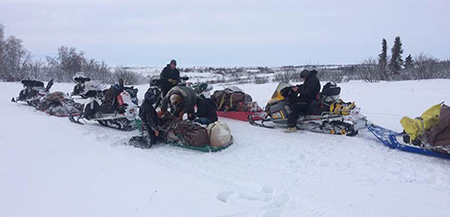
The next day, Doug sent me out with Pat, Sam and Chris to check Chris and Pat’s trapline. We met at the gas station. As we left for the river, Pat was in the lead with me bringing up the rear. When I got to the river, I saw Pat’s sled at a slant into the water at the river’s edge. The sled was in the water about half way up the skis and just covering the hood. Pat said he was done for the day because the engine had taken in water and would need to be drained before it was run again. Sam tied off a line to the back of Pat’s sled and pulled it out of the water and back up onto the parking lot. Pat called Doug, who came with a trailer to take the sled to the mechanic. Sam, Chris and I continued on to another spot to get on the Kuskokwim River and were soon on our way.
We rode about an hour and came to a village seemingly out of nowhere. A 10’ sled was in front of town on the Kwethluk River, with about half a dozen spruce logs about 8 inches in diameter, destined for sale in Bethel, where there are few trees bigger in diameter than an inch or two. We continued on till we turned off into another tributary. We rounded a bend and stopped. The spot was Chris’s favorite place to fish in the summer for coho salmon, trout and pike. I saw a hole in the river ice with blood around it and wonder what made the mess. Later, out of nowhere, two girls on a four wheeler pass us. Where did THEY come from I think? I soon realize there are villages not far off but we can’t see much running in the river bed. We stop every five miles or so like we did moose hunting, and have a bite to eat or sip coffee as we like. We’re in no hurry.
We continue on and we’re soon checking sets for wolverine, wolf, fox, otter and lynx. Most of the sets are snares. I’ve primarily trapped with conibear traps near the ocean, so this upland trapping was new to me. We get nothing in the first few sets, and then I see a fox in a snare set for wolverine. The fox is not happy to see us. Sam shortens up the leash of the snare lead, conks the fox on the head to stun him, then kneels on its chest till it expires. A quick death.
We get one more fox on the checks. We get to all the traps but the one furthest away and can’t get to that one today because there’s too much overflow on the river ice. We’d gone 67 miles when we turned back to town.
When we get back to Chris’s favorite fishing spot, there are a bunch of four wheelers and people fishing. Some are fishing in the hole that I saw blood in, and there’s a live pike in a little puddle of overflow. That answers that question. Another group is across the river checking a whitefish net set under the ice. Everybody is happy. It seems like the winter season is what people look forward to here, as long as it’s cold enough for the rivers to freeze and it snows. Winter is when the most country is accessible; when snow conditions and fish and game populations are good, it’s a happy time to hunt, trap, and fish.
We return to town. Sam leaves me with the two fox at Doug and Val’s, and Doug takes the two fox to the skinning shed for Pat to take care of. I start butchering the moose after a dinner of specklebelly geese stuffed with apple and raisins. That Dougie can cook. I butcher till late in the night listening to old country songs on the legendary local radio station KYUK.
The next day was blowing and raining. A perfect day to butcher. Doug and I cut meat all day. We carved the meat from all the bones except the ribs and put it into game bags. Pat’s wife wants the femurs for bone stock. The rest of the bones we rehang to keep clean in case someone wants them for soup. We break for lunch and eat chili with muskox burger. Did I mention that Dougie can cook? We continue cutting into the night, listening to the late John Active’s Yupik language call in show on KYUK. We both enjoy the show, especially the laughter, even though we don’t know the language. We finish the meat cutting after 10 pm. Then we get a scale to weigh each bag so we can load the boxes near to their maximum allowed weight for air freight of 100 lbs each. I’m lucky to find waxed fish boxes at the AC store, and buy 7 of the last 8 in town the next day. We decide I’m leaving in two days, and I order a one way mileage ticket to Juneau.
The next day, we checked Doug’s trapline near town. As Doug and I check empty trap after empty trap, I yelled words of encouragement to him like "Is this your first year trapping", "Do you know what you're doing", and "Are we ever gonna catch one". It was a beautiful sunny day. Part way through the trap checks, we cross the Kuskokwim and travel through Napaskiak, with its beautiful Russian Orthodox Church and adjoining graveyard of brightly painted crosses. We cross a small river and travel through Oscarville, with its above ground outdoor basketball court made of wood. We check several more traps on the way to town, and Doug takes me up on a hill where we can take in the vastness of the lower Kuskokwim River and surrounding wilderness.
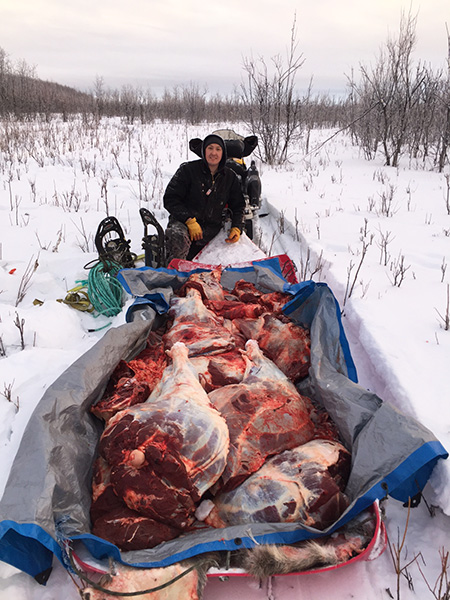
We travel through willow patches looking for ptarmigan on the way back to town, but the birds haven’t migrated in yet. When we reach the house, I walk down to Pat’s trapping shed. I watch as Pat deftly skins four fox, fleshes them, and puts them on stretchers to dry. He does it methodically, with no wasted motion. He could do it in his sleep. We talk as he processes the hides without thinking. It was interesting to see how few cuts are actually made when skinning a fox. There are a few cuts getting around the hind end, pulling out the tail, then working the hide down the body like a sock with only hands, pulling the ear cartilage through with a screwdriver, then cutting through the eyes and nose.
Pat has caught lots of fox this winter, and gets most of them right near town. He said some years there are 700 fox taken by the local trappers within a few miles of town. He described how they come through in waves. He'll get 10 or more on opening day, then nothing for several days, then eight more, then nothing for a few days, then six more, and so on. Sounds a lot like salmon trolling.
When he finishes pinning the last fox on a stretcher, we head for Doug and Val’s for dinner. We sit around and yak for an hour until Pat’s partner Louise can join us. We have salmon patties, cold canned green beans with Italian dressing, and salad for dinner. Dang it, that Dougie can cook. Val breaks out her favorite desert - ice cream - and Doug brings on some chocolate syrup and pecans.
On the last day, I got up a little after 6:30 am to pack all the meat. I got six boxes filled to between about 85 and 95 lbs, and the seventh box was about 30 lbs of ribs. Those we left with meat on the bone for Doug’s brother Bob in Wrangell. I return to the house about an hour later and get some coffee on. Doug stirs and comes downstairs and we drink coffee in the dark. A little after 8, we load the boxes into the truck and go to Alaska Air cargo to ship the meat.
Like everything here, it’s all casual. The two agents are cousins and Yupik, and one says the other acts a little batty sometimes so you have to excuse her. Doug knows her of course, and asks if her mother needs any meat. The daughter replies they’ll always take meat. Doug says he still might go muskox hunting and he’ll drop some off if he does. Then I think of all the bones we kept clean at Doug’s and ask her if they’d like the bones for soup and she said they’d love them. I pay for the air cargo - about $350 - and we return to the house happy we have a home for the moose bones.
After I pack my gear to leave, I help Doug dismantle the hanging racks and we put the bones on the sled for the granny and her daughter. There’s a pile of meat scraps trimmings and bone cartilage to store for trapping bait. We pull up the tarp that was under the hanging meat that apparently wasn’t all waterproof. Doug puts water on the shed stove, then pours the heated water onto the blood stain, then puts sawdust on top of that to soak up the blood. Apparently, this has happened before.
I ask if I should scrub it with a brush. He says it’s a shed. For butchering. Don’t worry about it.
A week in Bethel and I feel like I’ve been to a paradise. Climate warming is bringing changes to the area. Willows are growing in more abundance, making more feed for moose. The houses built using permafrost construction techniques are sagging because the permafrost is melting, creating headaches for homeowners. Warmer winters mean less snow and probably more dangerous river ice conditions than in the past. Who knows what it’ll look like in another couple decades. My guess is people here will adapt as they always have.
One thing for sure is a cooperative agreement between the people of the region to limit the moose take for five years back in the early 1990s through the work of the late Randy Kacyon, alongside the increasing food source, has created an abundance of moose on the lower Yukon River.
Doug and Val and I head to the airport after Doug makes us salad omelets for breakfast. We say our goodbyes and I pass through security. Waiting for the plan to board, I look at my air cargo bill and note that under contents it reads “moose meet” and I smile. An apt title to the trip of a lifetime that I hope to be many more.
Mark Stopha is a fishery biologist in Juneau.
Subscribe to be notified about new issues
Receive a monthly notice about new issues and articles.
